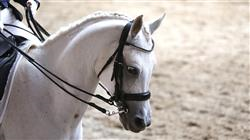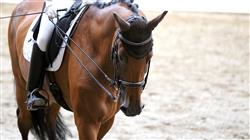University certificate
The world's largest faculty of veterinary medicine”
Description
Equine Rehabilitation is a growing discipline that requires trained professionals to care for horses"

This postgraduate diploma in Horse Functional Anatomy, Biomechanics and Training approaches this discipline through the experience of several internationally accredited rehabilitation specialists, including information that cannot be found in any other online or classroom program, deleivered by a faculty of the highest level.
The field of Horse Functional Anatomy, Biomechanics and Training has experienced enormous growth in recent years, currently representing a clinical speciality widely demanded by owners, riders and other equestrian professionals. One of its main pillars is an exhaustive and meticulous knowledge of the horse's anatomy, both from the functional point of view as well as its biomechanical behavior.
The movement of the horse is developed fundamentally in three gaits: walk, trot and canter. However, as in human sport, each equestrian discipline requires specific biomechanics and therefore has specific locomotor requirements. Understanding this facilitates an understanding of appropriate movement pattern or, on the contrary, the detection of a possible limiter of sports performance. All this has a very important implications for the clinical interpretation of numerous pathologies of the musculoskeletal apparatus of the horse.
Likewise, achieving optimal sporting performance of a sports horse depends to a large extent on proper training planning. With proper and individualized planning, in addition to achieving performance appropriate to the genetic potential of the horse, the risk of fatigue, exhaustion and, therefore, musculoskeletal injuries and overtraining will be reduced. It is important to know how to enhance the three basic capabilities of an athlete: endurance or aerobic capacity, speed or anaerobic capacity and strength.
This postgraduate diploma provides students with specialist tools and skills to enhance their professional practice and work on key competencies such as knowledge of the day-to-day realities of veterinary professionals and responsibility in the monitoring and supervision of their work, as well as communication skills for effective teamwork.
Don't miss the opportunity to take this postgraduate diploma in Horse Functional Anatomy, Biomechanics and Training with us. It's the perfect opportunity to advance your career"
This postgraduate diploma in Horse Functional Anatomy, Biomechanics and Training contains the most complete and up-to-date scientific program on the market. The most important features include:
- The examination of practical cases presented by experts in equine physiotherapy and rehabilitation
- Graphic, schematic, and practical contents which provide scientific and practical information on the disciplines that are essential for professional practice
- The latest news on horse biomechanics and training
- Practical exercises where self-assessment can be carried out to improve learning
- Special emphasis on innovative methodologies in horse biomechanics and training
- Theoretical lessons, questions to the expert, debate forums on controversial topics, and individual reflection assignments
- Content that is accessible from any fixed or portable device with an Internet connection
This Postgraduate Certificate 100% online and will enable you to combine your work and studies while increasing your knowledge in this field”
The faculty includes veterinary professionals, who bring their professional experience to this program, as well as renowned specialists from leading societies and prestigious universities.
The multimedia content, developed with the latest educational technology, will provide the professional with situated and contextual learning, i.e., a simulated environment that will provide immersive education programmed to learn in real situations.
This program is designed around Problem-Based Learning, whereby the professional must try to solve the different professional practice situations that arise throughout the program. For this purpose, the professional will be assisted by an innovative interactive video system created by renowned and experienced experts in Horse Functional Anatomy, Biomechanics and Training.
This program comes with the best educational material, providing you with a contextual approach that will facilitate your learning"
Access this complete postgraduate diploma in Horse Functional Anatomy, Biomechanics and Training and avoid potential injuries in these animals"
Objectives
This postgraduate diploma in Horse Functional Anatomy, Biomechanics and Training is aimed at facilitating the performance of the veterinary professional with the latest advances and most innovative treatments in the sector.

Our goal is to offer quality professional development so that our students become the best in their profession"
General objectives
- Examine the different methods used for objective measurement of the locomotor pattern of horses by means of biomechanical studies
- Analyze the functional anatomy and biomechanics of the main locomotor units in horses
- Define movement patterns in the horse’s natural gaits
- Examine the locomotor demands and specific exercises in the main equestrian sports disciplines
- Plan and time a training program according to horse fitness levels, competitive objectives and the type of equestrian discipline
- Design stress tests according to the equestrian discipline, deciding on parameters to be measured and how to interpret them
- Establish the diagnostic protocol to be followed in the case of a horse with loss/ reduction/ lack of sporting performance
- Develop protocols to treat and prevent pathologies associated with physical exercise and training, including overtraining syndrome
- Analyze what motor control is and its importance in locomotion and rehabilitation
- Evaluate the main tools and exercises of active therapy
- Develop clinical and in-depth reasoning on the use of therapeutic exercises in the horse
- Generate autonomy when developing active re-education programs
Specific Objectives
Module 1. Applied Anatomy and Biomechanics of Horses
- Characterize the gaits of walk, trot and canter from a kinetic and kinematic point of view
- Examine the influence of neck position on the biomechanics of the dorsum and pelvis
- Analyze the biomechanical characteristics of the pelvic limb and its relation to walk, trot and canter quality
- Analyze locomotor modifications associated with speed and training in horses
- Characterize the biomechanical disorders found in claudication
- Develop variations in movement quality induced by patient age and genetics
- Evaluate the influence of the morphological characteristics of the hoof on the biomechanics of the thoracic limb
- Analyze the different types of shoeing and their effect on the biomechanical characteristics of horse hooves
- Establish the interaction of the saddle and rider on the horse’s locomotor pattern
- Evaluate the effect of different embouchures and performance systems on the characteristics of horse movement
Module 2. Exercise Physiology and Training
- Examine respiratory, cardiovascular and musculoskeletal changes in response to submaximal and maximal, short and long duration, and intermittent exercises
- Understand the importance of histological and biochemical muscle changes with training and their impact on aerobic capacity and the respiratory, cardiovascular and metabolic response to exercise
- Establish how heart rate and blood lactate monitoring is performed, as well as measurement of ventilatory volumes and VO2 oxygen consumption
- Identify the mechanisms of thermoregulation of sport horses, associated pathologies, consequences and action protocols in case of thermoregulatory alterations
- Specify training strategies to develop oxidative potential, strength and anaerobic capacity
- Present strategies to reduce or delay the onset of fatigue during various types of exercise
Module 3. Therapeutic Exercise and Active Kinesitherapy
- Analyze the neuromuscular physiology involved in motor control
- Identify the consequences of disrupted motor control
- Define the specific tools that are used and how to include them in a motor control re-education program
- Examine the elements to consider when designing an active kinesitherapy program
- Define Core Training techniques and their application as a therapeutic exercise
- Define proprioceptive facilitation techniques and their application as a therapeutic exercise
- Evaluate the characteristics and biomechanical implications of some of the main exercises from a therapeutic point of view
- Evaluate the effects of active work

A unique, key and decisive training experience to boost your professional development"
Postgraduate Diploma in Functional Anatomy, Biomechanics and Training in the Horse
.
If you are a professional in the field of equine physiotherapy, or if you want to specialize in this area, TECH offers you the opportunity to take the Postgraduate Diploma in Functional Anatomy, Biomechanics and Training in the Horse, an online program designed to train experts in the field and provide essential tools and knowledge for the correct evaluation and treatment of pathologies of the locomotor system in equines. This program, taught by recognized specialists in equine physiotherapy, is presented as a quality, flexible and accessible virtual training option that will allow you to combine your studies with your work and personal commitments. In addition, thanks to the use of the most innovative technologies, you will be able to access the content of the courses from anywhere and at any time. Among the benefits of studying at TECH, we highlight the possibility of learning in an interactive way and with a practical approach, based on real cases and with the support of advanced didactic resources. In addition, you will have access to an online platform that will allow you to be in permanent contact with your fellow students and specialized tutors, which will foster your collaborative learning and provide you with constant support throughout the training process.
Specialize in physiotherapy for horses
.
The curriculum will cover key topics such as the anatomy and physiology of the horse's locomotor system, the biomechanics of movement and the most common pathologies, as well as equine training and re-education. All this, with a focus on the application of specific therapeutic techniques, such as osteopathy, acupuncture, electrotherapy, among others. If you want to specialize in equine physiotherapy, this Postgraduate Diploma is the answer. You will be able to acquire the knowledge and tools necessary to evaluate and treat pathologies of the equine locomotor system, and all this from a practical and interactive perspective, with the constant support of specialized tutors and the flexibility you need to combine your studies with your work and personal responsibilities. Enroll now and become an expert in equine physiotherapy!""








